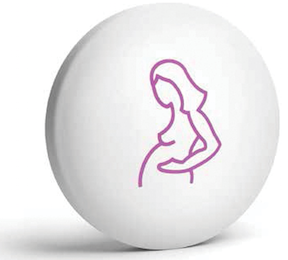Class A morning sickness medication gains FDA approval after decades of being misunderstood
Major Indications
Diclegis is used for pregnancy-associated nausea and vomiting. Certain patients respond well to ondansetron (Zofran), which is a common first-line agent for nausea in the ED. However, ondansetron is ineffective for some pregnant patients, and is cost-prohibitive to take at home for others. Pyridoxine/doxylamine is a safe medication for pregnant patients (Class A), and may provide superior symptom relief in some cases.
Recently in the news for
The combination pyridoxine/doxylamine pill, Diclegis, was approved by the US FDA in 2013. It is the recommended first line medication for pregnancy-associated nausea and vomiting in Canada.
How it works
The exact mechanism of action of pyridoxine is unclear. Doxylamine is an anti-histamine active on central and peripheral H1 receptors. It acts on the chemoreceptor trigger zone to reduce nausea.
Notable History
Pyridoxine/doxylamine was first marketed in the US in 1956 as Bendectin. Unfortunately, a string of lawsuits were brought against the drug company, claiming Bendectin caused fetal malformations. Even though the lawsuits were nonmeritorious, the legal costs of going to trial were enough to drive the company out of business [1] and the medication was voluntarily pulled from the market in 1983. The FDA never found any link between Bendectin and fetal malformations, and in at least one major lawsuit, teratogenicity data were later found to have been falsified. Despite this, no new medications for nausea in pregnancy were approved for 30 years. After its withdrawal from the market the frequency of hospitalization for nausea and vomiting in pregnancy doubled [2]. In other countries the combination has still been used, and many obstetricians in the US have continued to recommend it off-label. In 2013 the US FDA approved a new combination pill made by a Canadian company, marketed as Diclegis [3].
Adverse events
The most common side effect is drowsiness (occurring in 14% of patients), a result of the central anti-histamine activity. Serious side effects are extremely rare. Patients should be instructed to take the medication at night when starting it, and to use caution if taking it prior to driving or operating machinery.
Cautions
Pyridoxine/doxylamine bears the remarkable pregnancy safety rating of Class A and has been studied in more pregnant patients than any other medication [3]. In fact, the American College of Obstetricians and Gynecologists say “taking Vitamin B6 plus doxylamine is safe and should be considered a first-line treatment.” By comparison, other commonly used medications such as ondansetron (Zofran) and promethazine (Phenergan) are Class C, and metoclopramide (Reglan) is class B.
Dose Adjustments
One tablet contains 10mg of pyridoxine and 10mg of doxylamine. Patients can take 2-4 tablets daily. The recommended starting dose is 2 tablets taken at night, since the main side effect is sleepiness. If this is ineffective, patients can add a tablet in the morning, and then another tablet in the afternoon. Unlike ondansetron or promethazine that can be taken on a PRN basis, however, pyridoxine/doxylamine should be taken on a daily, scheduled basis to be effective. There are no renal or hepatic dosing adjustments defined.
Special Features
The drug combination can also be made from over-the-counter medications of pyridoxine (vitamin B6) and doxylamine (Unisom). Or it can be given as prescription Diclegis.
Cost
Prescription Diclegis (10mg pyridoxine/10mg doxylamine) costs around $570 for 100 tablets. Many patients may require 2-4 tablets per day. Over-the-counter 25mg pyridoxine and 20mg doxylamine each cost $5-10 for 100 tablets. The prescription version may be cost-prohibitive for some patients, in which case the over-the-counter combination is a viable alternative.
REFERENCES
1. Wing DA, Powers B, Hickok D. U.S. food and drug administration drug approval: Slow advances in obstetric care in the united states. Obstet Gynecol. 2010;115(4):825-833.
2. Kutcher JS, Engle A, Firth J, Lamm SH. Bendectin and birth defects. II: Ecological analyses. Birth Defects Res A Clin Mol Teratol. 2003;67(2):88-97.
3. Slaughter SR, Hearns-Stokes R, van der Vlugt T, Joffe HV. FDA approval of doxylamine-pyridoxine therapy for use in pregnancy. N Engl J Med. 2014;370(12):1081-1083.




1 Comment
Great article! Definitely a practice changer. But please note Zofran is class B (http://www.drugs.com/pregnancy/ondansetron.html)